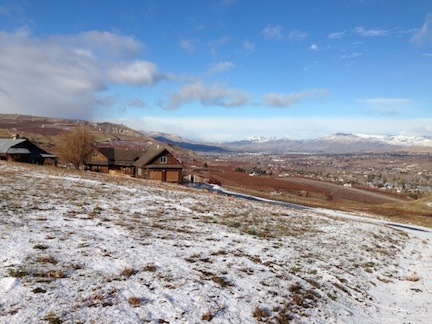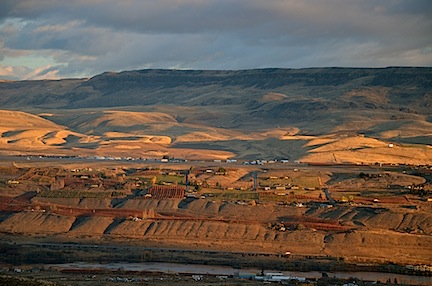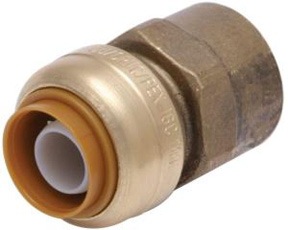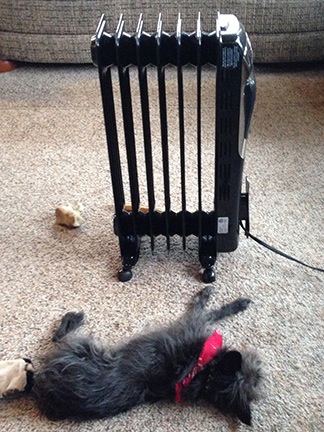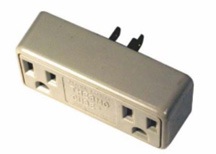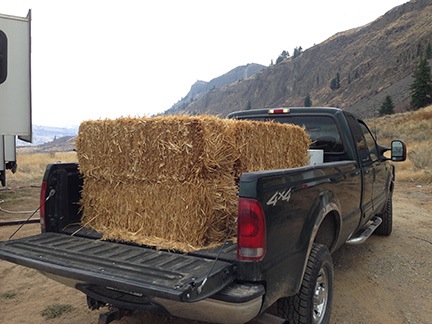Shaking the rust off.
(This story starts with a Prelude and a summary (with photos) of Day 1.)
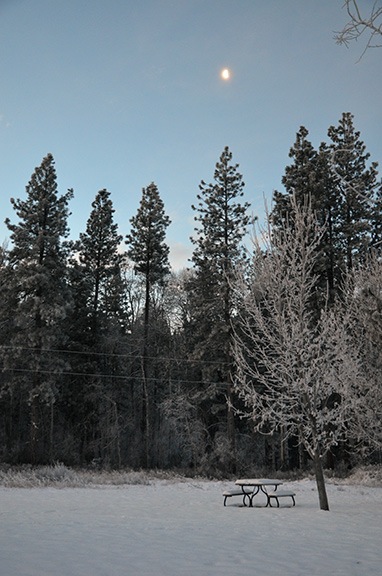
The sky was mostly clear in the morning, with a half moon hanging high.
Once I set the thermostat down to 60 — thus preventing the rather loud heater from turning on and off all night — I slept like a log. The room was plenty warm and the bed was cozy, with lots of blankets. Penny left her bed empty and, instead, made a sort of nest on the comforter next to me. It was very quiet. I left the curtains wide open so I could see the stars and moonlit terrain when I woke up.
In the morning, I took Penny out for a walk. The fog that had been drifting low over the snow-covered fields the night before was gone. The sky was mostly clear with the last quarter moon hanging high in the sky.
A good day for skiing.
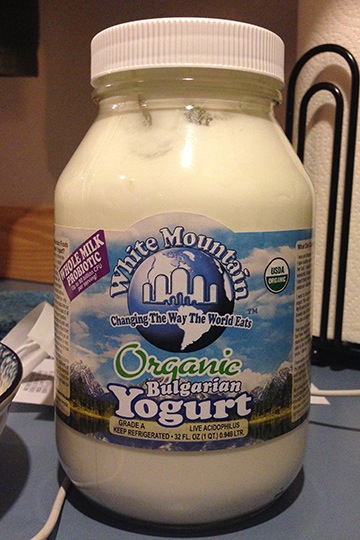
Yes, I bought organic Bulgarian yogurt. I don’t recommend it.
Back in our loft cabin, I made coffee and a breakfast of organic “Bulgarian” yogurt and granola that I’d brought from home. I don’t recommend Bulgarian yogurt; it’s extremely sour. I also cut up the huge Honeycrisp apple I’d bought the day before and stowed it away in my daypack with a bag of almonds for snacking later on.
Outside, the sun’s first light was illuminating the snowy mountains that surrounded the Methow Valley. As I washed up, did the dishes, and waxed my new skis for the first time, I found myself really looking forward to the day ahead of me.
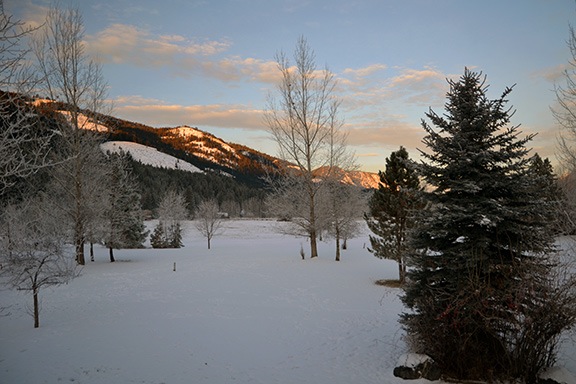
I never get tired of seeing the sun’s first light hit mountains and other landforms, bathing the highest points in a golden glow.
Suiting Up
At about 8:30 AM, Penny and I suited up with our winter gear.
For me, that meant skin-tight leggings made of a fabric that would wick sweat away from my body and what I can only call “snow pants” over them. If you’ve ever been a kid in a cold climate, you know what I’m talking about: nylon pants with a quilted filling. Mine were black with zip pockets, wide legs, and an inner liner near the bottom with elastic that closed around each of my legs. I also layered up on top with another tight wicking fabric undergarment, a fleece sweater, and my bright red waterproof shell. All of these things were new — I had no use for clothes like this when I lived in Arizona, since I seldom went north to the higher elevations where cold winters prevailed. On my feet I wore an ancient pair of thick wool socks — I’d fetched them out of storage before my trip — and a brand new pair of Sorel snow boots that I could also wear with the snowshoes my brother had gotten me for Christmas. I also had a scarf (of course) and a merino wool Buff that I wore as a sort of turtleneck, with the option of turning it into a hat or a balaclava. And thick red ski gloves — did I mention those?
Penny really has trouble with her boots.
Penny’s attire was simpler: she wore her red quilted parka with the fleece lining. I didn’t put on her boots because she can’t really walk in them. Besides, I had a feeling she wouldn’t be doing much walking in the snow anyway.
You might think I was overdressed and I probably was. But the truth of the matter is that I really don’t like to be cold. I made this one-time investment in cold weather gear so I’d be comfortable out on the trail. I was embracing the winter season the only way I knew how.
The Back Road to Mazama
On my way to Mazama on Route 20 the day before, I’d seen a left turn for Wolf Creek Road about halfway between Winthrop and Mazama. The place I was staying was on Wolf Creek Road, but I’d gotten there from Winthrop. Could the same road keep going past my place and eventually meet up with Route 20 on the way to Mazama?
I looked at the topo map I’d saved into Gaia GPS on my iPhone and iPad. It sure looked like it did. And since I’m the kind of person who’d rather explore “shortcuts” than drive the long way around on the beaten path, I decided to give it a try.
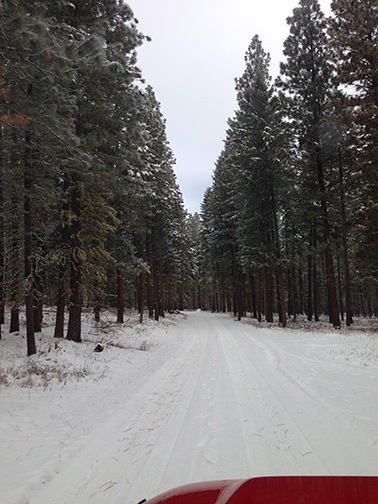
Paved or unpaved? Can you tell? Does it matter? It was a pleasant drive through the woods.
The drive turned out to be very pleasant. About a half mile down the road from where I was staying, a “Pavement Ends” sign announced the end of pavement — it didn’t matter because the roads hadn’t really been plowed in the first place. (In all honesty, I thought all of Wolf Creek Road had been unpaved.) The narrow road, which I could follow from the tire tracks of the few vehicles that had driven it before me, wound through a forest of tall pines, twisting and turning, climbing and descending. After a few slides, I threw the Jeep into four wheel drive and it stabilized. I drove at a steady 20 miles per hour, crunching over snow and long pine needles. Here and there were gated driveways and ungated forest roads turning off into the snowy woods. I realized that I’d need to come back when the snow was gone, possibly with a friend and some camping gear, to explore some of those roads. I really do love exploring back roads with my Jeep.
Within just a few miles, the forest opened up to some fields with homes and snow-covered farm equipment scattered here and there. The tall grass was covered with thick frost — a remnant of the previous evening’s low fog. In some places, I could see clear up the valley, to the towering mountains of the North Cascades.
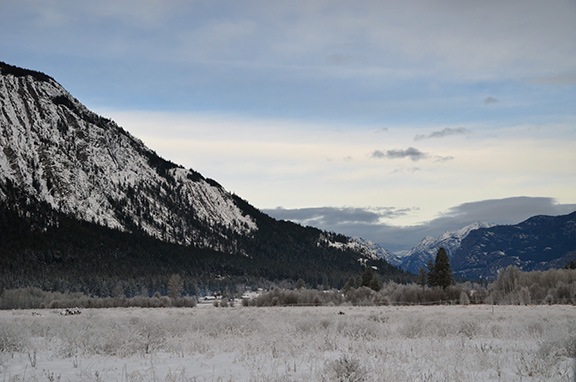
Although the sky was mostly clear, the sun was hidden behind clouds to the southeast, leaving the valley in shadows.
The road turned sharply to the right. A moment later, I was back on Route 20. My morning back road adventure had been less than 5 miles long.
Ski Lesson
It’s important to note here that I’d been cross-country skiing before. Way back in the 1980s, when I first hooked up with the man I’d later marry, we took up cross-country skiing and did trips in the Catskill Mountains of New York State. I clearly remember going out one snowy day on trails near the Mohonk Mountain House near New Paltz. I remember the silence of that afternoon, with the thick wet snow packing up on the bottom of our skis as we cut new trails.
Back then there was only one kind of cross-country skiing — what they now call “classic” — and the skis and shoes were very basic. I still had my set but I left them behind in Arizona when I moved out of my Wickenburg home in May 2013. I didn’t miss them — they were junk — and the crappy plastic shoes had likely been ruined by the mice that often lived in our garage.
New technology had greatly improved both the skis and the boots. I bought a new setup in November. The only thing I miss from my old setup is the blue plastic clips that held the skis and poles together, making them easier to carry and store. I can’t seem to find a set of those anywhere, although I did get a set of ski bones that hold the skis together nicely.
So there I was, in the biggest cross-country ski area in the country, with a brand new cross-country ski setup. But I hadn’t been skiing in at least 20 years.
That’s why I signed up for a lesson.
I showed up early at the Methow Valley Ski School. While I waited for my instructor, I put on my ski boots (for the first time!) and put away my Sorels in the Jeep. Then I fetched Penny and my day pack and settled in to wait on a bench inside where it was nice and warm.
I can’t remember the ski instructor’s name. She was a Swiss woman with an accent very similar to my grandmother’s German accent and almost identical to that of a Swiss couple I was friends with in Wickenburg. The other student was a young Japanese man who didn’t speak English. He was staying with a couple around my age who chatted with me as they dropped him off for his lesson.
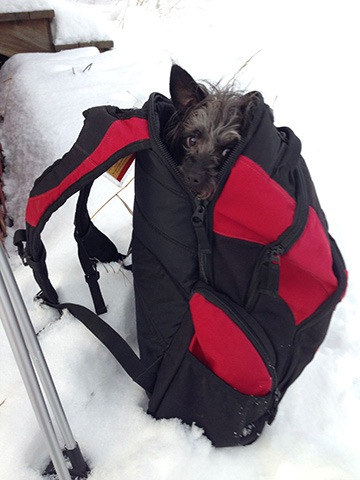
At just 7 pounds, Penny is easily carried in a day pack. In fact, I had to pad the bottom so she could stick her head out.
Needless to say, the lesson was interesting, mostly because of the amount of miming the instructor had to do to communicate with the Japanese guy. We started indoors where we learned how to put on the skis. Even that was different from the old setup. Then I put Penny into the day pack, zipped it so just her head stuck out, slung it over my shoulder, and followed the others outside with my skis and poles. We spent the next hour practicing basic skills on the trails near the ski school shop.
The Japanese guy was pretty funny. He fell a lot and got lots of practice getting up. I only fell once, but I did it spectacularly. I lost my balance coming down a small hill. Because I didn’t want to fall backwards on top of Penny, I purposely fell forward. The backpack shifted up hard and Penny went flying over my head into the snow. We all had a good laugh and it took some time for me to get back up without taking the skis off. Then I got Penny back into the bag and the lesson went on.
One of the things that shocked and pleased me was what “groomed trails” meant. The trails were wide and smooth and had obviously been sort of “raked” over. On either side of the main trail were a pair of cross-country ski tracks, already laid out in the snow at the perfect width. Skiing in these tracks was a real breeze — and a real treat. In my previous cross-country skiing experience, the first person in our group would make the tracks and they were rarely evenly spaced. This alone made the ski pass worth the money I’d spent for it.
Lunch at Jack’s
It was 11:30 by the time the lesson was over and I was hungry for lunch. The ski school folks made some calls and found a cafe down the road, Jack’s Hut at the Freestone Inn, that was open for lunch. I drove over, leaving Penny in the Jeep. The owner was manning the place, which was more of a snack bar than a full-blown restaurant. I sat at the counter where I could watch him work. I had an excellent bowl of chili — probably from a can — with cheese and a chicken quesadilla he made while I looked on.
I was just starting on my quesadilla when the Japanese student and his two American hosts came in. Soon they were seated at the counter with me, enjoying the same food. We chatted a bit about the area, real estate, and skiing. We studied my map and they offered some suggestions for places to go skiing that afternoon.

Here’s a map of the area where I planned to ski. You can download the entire map here.
Then I was done eating and it was time to go. The sun sets early in Washington in the winter time and I was hoping to ski with the sun still on me.
Solo Skiing
Penny and I headed out to the North Cascades Basecamp parking area. I parked and opened my door while I got my things together. Some movement on my left caught my eye and I found myself looking almost eye-to-eye at the biggest black dog I’d ever seen.
The dog was friendly, of course, but quickly frustrated by Penny darting out at him from under the Jeep. I had to snatch her up and put her in the day pack so she’d leave him alone. He wandered off while I chatted with some other skiers who were just getting their skis on when I arrived.
A while later, I was on the Base Camp trail with Penny in the day pack on my back. This particular trail wound through the woods with gentle hills that proved to be quite a challenge for me. I had one fall along the way — fortunately, Penny wasn’t launched out this time. It did take me a minute or two to get back on my skis.
I wasn’t alone on the trail. There were plenty of other skiers, most of whom did not used the classic ski tracks. They were skating on skis. It was wonderful to watch and I was envious of their skill. I decided to visit the local skating rink back home to build up my general skating skills and balance.
Despite the cold — it was between 25°F and 30°F out on the trail — I worked up a nice sweat. Although I never felt uncomfortably warm, I certainly never felt cold, either. It was very pleasant to be outdoors in the winter time, keeping active enough to keep warm, enjoying the steady slush-slush-slush sound of my skies in the tracks as I wound through the woods.
Eventually, the trail went down to a pair of portable bridges across a stream bed. The bridges were designed to be skied over and I had no trouble with the first one. But while I paused to take a photo, I decided that I wanted to practice on easier trails to really get the hang of skiing before I tackled the kind of hilly trail I was on. So after I shot the picture, I crossed back over the bridge and skied back to the Jeep.
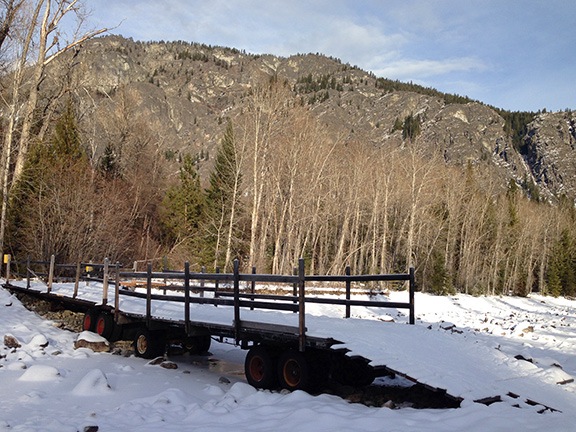
This was the first time I’d ever seen a portable bridge. Click here for a large panorama of the area shot with my iPhone.
According to the GPS Track app on my phone, I’d skied about a mile and a half. Not very impressive.
I drove back to the place I’d started the day: the easy trails around the Mazama Store and Ski School. Once again, I got out with my skis and put Penny in the day pack. Then we were off down the trail. It was much later in the day and most of the other skiers were on their way back in. But there were other people going out. Although most of them passed me, I managed to pass someone even slower than I was.
I did another two miles in nearly an hour of skiing. I realized that I hiked faster than I skied. I needed practice!
Sun Mountain
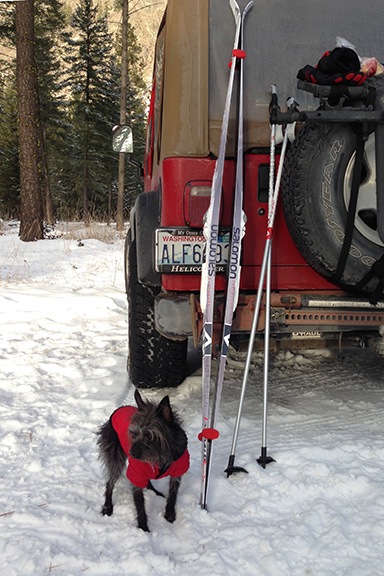
Here’s Penny in her parka.
I let Penny out to take a quick walk before we climbed back into the Jeep with the skis. I steered us down Route 20.
Winthrop was completely deserted. Everything was closed and not a single car was parked in town.
I decided to check out Sun Mountain Lodge, which was about 10 miles from downtown Winthrop. I figured I’d see what the place was like and, if I was hungry later, I’d go back for dinner.
But as I drove us up the long and winding road, I started to rethink that. I’d had a long day; did I really want to make the 20 mile round trip twice in one night? It all depended on what I found at the end of the road.
Along the way, I passed Patterson Lake, a mile and a half long lake that was completely frozen over. There were numerous skaters out on the north end of the lake, including hockey players who were playing on a shoveled-out arena. There was even an ice fisherman sitting alone over a hole. As I drove alongside the lake I realized something I’d never thought about before: this area of Washington was a winter sport destination.
If you’re reading this and know winter sport destinations like those in Colorado and Vermont and Utah, you’re probably saying, “Duh.” But this is completely foreign to me. When I lived in New York and New Jersey, we had winters that were just as cold and often as snowy as the winters here. Back there, we had winter sports, but few people really took them seriously. Sure, the skating pond in town was a gathering place for skaters and some hilly areas had sledders. And many people grabbed their skis and headed to the slopes in the Poconos or Catskills. There was no snowshoeing and very little cross-country skiing or snowmobiling — mostly because there simply weren’t many established trails. These sports were just incidental to where we lived, simply because the weather got cold and snowy for a short time every year.
But in the Methow Valley, winter sports were taken very seriously. Why else would there be 200 km — that’s 160 miles, folks — of groomed cross-country ski trails, all mapped out on paper and signs and a Website and even an iPhone app? Why would there be a shooting range on a biathlon trail? Why else would there be snowshoe-only trails and snowmobile speed limit signs? Why else would ski rental and lesson places be open for business on Christmas day when it was tough to find a restaurant for lunch? Why else would there be dozens of people skating on a frozen lake in the middle of nowhere?
And realizing this made me feel really good about where I’d chosen to make my home. Because not only were they serious about winter sports, but they were equally serious about summer sports like hiking, biking, camping, boating, fishing, and so much more. There was no shortage of outdoor activities in north central Washington state with the perfect weather to enjoy it all.
The sun had gone down behind the mountains and clouds when I finally reached the Sun Mountain Lodge. It sits near the top of a mountain — Sun Mountain? — overlooking the Methow Valley. Ironically, the lodge is only 1-1/2 miles as the crow flies from where I was staying off Wolf Creek Road far below.
I left Penny in the Jeep and went inside. I was still wearing my skiing gear, right down to the boots. But when I got into the cocktail lounge for a hot beverage, I saw that I wasn’t the only one.
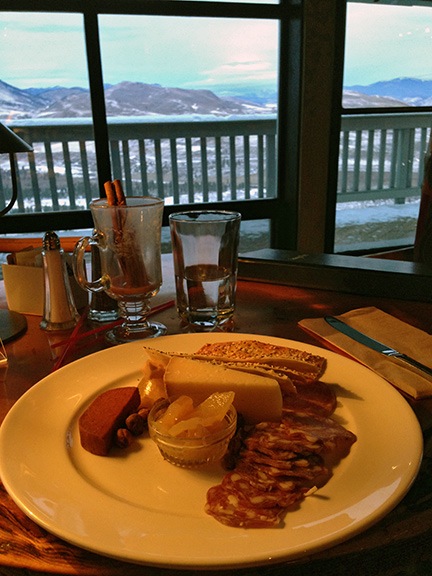
The meat plate was enough to feed two as an appetizer. I took my time and enjoyed looking out over the view.
I sat near a window where I could look out over the valley. I had a Spanish Coffee, which I found a bit sweet, and ordered a meat plate that included various sliced meats, cheese, crackers, and very spicy stewed apples. The waiter served it with a knife but not a fork; when I asked for a fork, he brought it but explained that because a restaurant reviewer gave them a bad review for serving it with a fork, they no longer provided forks unless asked. I wondered how I was supposed to eat the stewed apples without a fork. I also wondered whether he was trying to insinuate that I should have known better than to ask for one.
When I finished the Spanish Coffee, I ordered an Irish Coffee, which is more to my taste. I only ate half the meat plate — I was still pretty full from lunch — and took the rest to go.
Day’s End
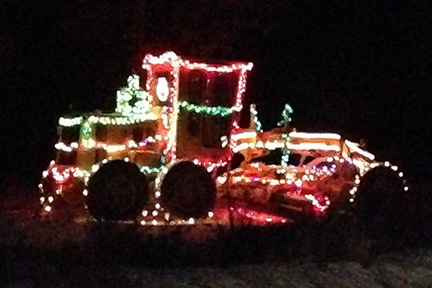
What else would you do with your road grader at Christmas time?
Penny was glad to see me when I got back. I let her out for a short walk, then loaded her back up and headed back down the hill.
The ice fisherman was the only one still out on the ice. I could see him clearly in the fading light from the light of his headlamp and another flashlight or lamp near his bucket.
By the time we got back to the main road, it was full dark. I drove slowly and carefully — there were signs all over the place about deer strikes and a friend back in Wenatchee had even warned me about deer at night. Sure enough, I saw one cross the road when I stopped to take a photo of a road grader decorated with Christmas lights.
Back at the loft cabin, I let Penny have a good run. Both of the downstairs units were brightly lit up with families celebrating Christmas away from home. Penny and I went upstairs, where I opened a bottle of wine and settled down with a book.
I was sound asleep by 8 PM.

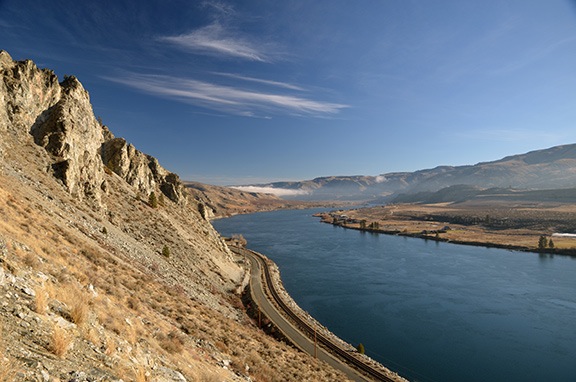
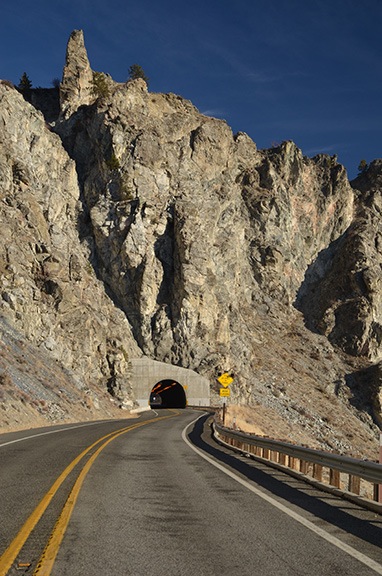
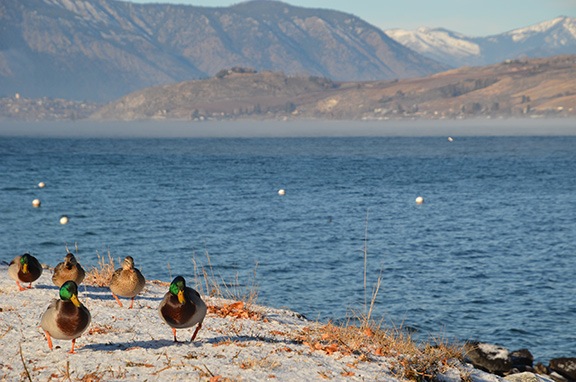
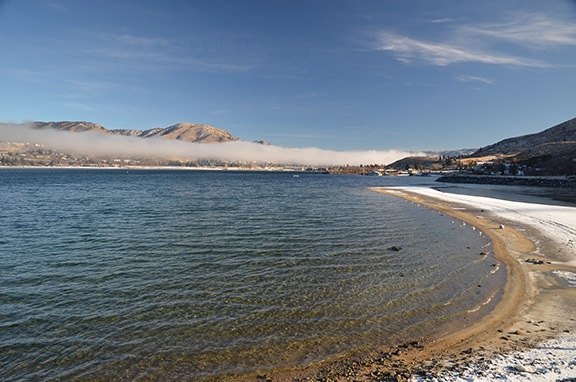
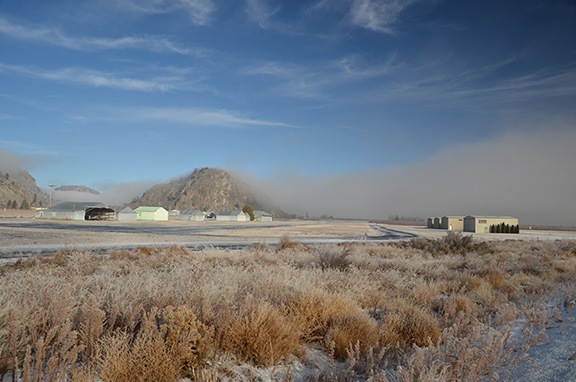
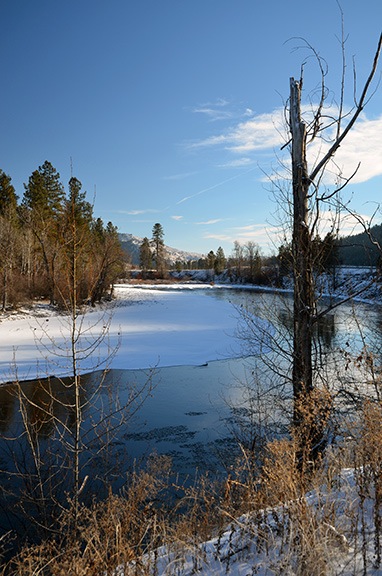
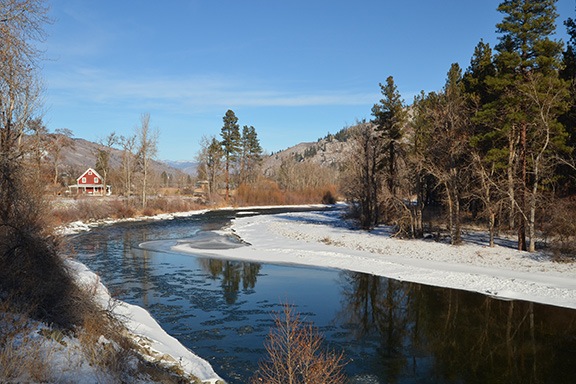
 A tiny bit of research led me to the website for the
A tiny bit of research led me to the website for the 
